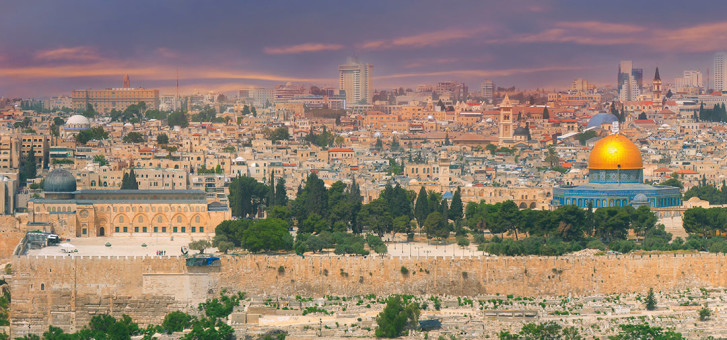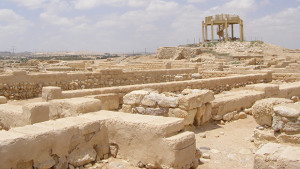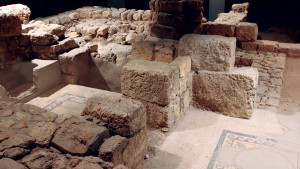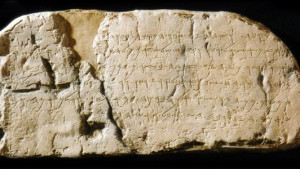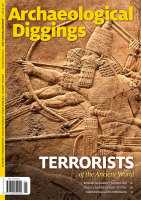OVER THE PAST TWO CENTURIES, A HUGE amount of archaeological work has been done in Jerusalem, revealing a city constantly connected with major historical events. Today, several archaeological projects, in addition to
temporary salvage excavations, are uncovering more and more of the ancient history of Jerusalem. Among others, areas of excavation include the City of David, remains adjacent to the Temple Mount, the Jewish Quarter and Mount Zion. The sites reveal people in residence well before 2000 BC, and that the city underwent expansion to its north and west, especially during the Kingdom of Judah and then the Roman period.
In a section of today’s Jewish Quarter, also referred to by the ancient designation “Herodian Quarter,” the Burnt House was excavated in the 1970s. This house, which dates to the first century prior to the AD 70 destruction of Jerusalem, is a wonderfully preserved example of a house belonging to a wealthy Judean who, as evidenced by the presence of ritual baths and ritual stone vessels, may have been part of the priestly class. Slightly to the northwest, in the present day Armenian Quarter, is the
“House of Caiaphas” on Mount Zion, another first century palatial residence appearing to belong to a priestly family, although its identification with the biblical Caiaphas is only tentative. Slightly to the south and just outside the present Old City walls, more recent excavations have uncovered a third mansion appearing to belong to yet another wealthy resident of the priestly class of the first century. It is becoming obvious that this neighbourhood of northwest Jerusalem, in the upper city, was the area in which lived the elite—those connected with Rome and the leaders of the religious establishment. Being near Herod’s palace (which became the Praetorium), easy access to the Temple, and the higher elevation all made it prime real estate within the city.
The archaeological site containing this third mansion, located on the beginning of the slope of the Western Hill in what was the southwest region of ancient Jerusalem, is today outside of the walls near Zion Gate. Excavations at this site, just south of Zion Gate and north of Dung Gate, have uncovered archaeological material spanning much of the occupational history of Jerusalem.
The area, now vacant, has yielded archaeological remains from the Ottoman period (1517–1917) all the way back to the Iron Age II (1000–587 BC), in the eighth century BC and the time of the Kingdom of Judah, and possibly even earlier to the Late Bronze Age (1500–1200 BC), when Jerusalem was a city-state in Canaan, as evidenced by a few of the Amarna Letters written by the king of Jerusalem to the pharaoh. Archaeological work has exposed Ottoman, Medieval Islamic, Byzantine and Roman period structures, in addition to various pottery and artefacts from several periods. Hellenistic (probably Seleucid and Hasmonean) and Iron Age II (Kingdom of Judah) material was also uncovered, but no architecture from these earlier periods has yet been discovered on the site. It is likely that any building masonry was recycled in later periods, although foundations of buildings from these early periods may be discovered at lower layers.
Artefacts include coins dating to the fourth century AD, when Jerusalem was part of the Persian province of Yehud; fragments of calcite vessels, likely imported from Egypt and perhaps dating to the Late Bronze Age, Hellenistic or Roman period; lead sling projectiles; a variety of oil lamps; nails; limestone ritual vessels; murex shells; stamped jar handles; and moulded glass from the Iron Age or Late Bronze Age. The sling projectiles are similar to sling stones but oval-shaped and pointed instead of round, typically date to Hellenistic or Roman times, although it is possible that they were used prior to the Hellenistic period. These sling bullets often contain inscriptions taunting the enemy or depictions of lightning bolts. They flew faster and penetrated armour better than the earlier round, stone sling balls (see 1 Samuel 17:40).
Many oil lamps and fragments of oil lamps from the Roman period, the Byzantine period and the early Islamic period have been found in excavations on Mount Zion. While most of the lamps are broken, a few examples have been discovered intact or in a condition that allowed restoration. The lamps were typically made out of clay, although a few notable examples of stone oil lamps from the Roman period have been discovered. Oil burning lamps were the sources of light after sunset and inside buildings with limited natural light (see Matthew 5:15) in biblical times. Iron nails of the type used in construction and crucifixion in antiquity (Acts 2:23) are also quite common finds. Stone jars, bowls and cups made of soft limestone local to the region are often found in sites of the first century, wherever the purity rituals of the Mosaic Law were practiced. These were usually used for ritual washing purposes and suggest that a family belonging to the religious elite may have lived in this first century mansion, since according to the Judean custom of purification, stone vessels did not become impure as did ceramic vessels (John 2:6).
Some of the stone bowls and jars found in excavations are quite basic, while others are intricately carved and likely belonged to a wealthy family. One of the stone vessels is of particular note. It is an almost intact cup containing a ten-line inscription in what has been described as both Cryptic Hebrew and the standard Aramaic script of the first century. While the inscription hasn’t been completely deciphered, it appears to relate to the going up of priests to the Temple, and it contains the name of God, YHWH. The murex shells, from a type of Mediterranean sea snail, are waste in the production of Tyrian purple dye, extracted from a gland in the snail. This dye was used in garments for royalty, the wealthy and the priesthood (see Mark 15:17; Luke 16:19; Exodus 28:6).
From the Iron Age, stamped jar handles dating to the period of Hezekiah around 700 BC, inscribed with LMLK, meaning “belonging to the king,” have been discovered on Mount Zion. These jar handles were stamped with the seal of King Hezekiah of Judah (reigned ca. 716–687 BC), which was a winged scarab, and the stamps seem to have indicated that the contents were taxes in the form of goods paid to the royal house in storage jars. Artefacts such as the calcite vessel fragments and the moulded glass, which date earlier than Hezekiah, complicate a full understanding of the site. Since these artefacts were found “out of context” rather than on a floor or living surface with accompanying pottery, we can only hypothesize the date of manufacture based on the shape and materials. It does, however, suggest that the Western Hill area of Jerusalem could have been occupied earlier than the eighth century BC.
Coins in Jerusalem, which serve as important chronological and historical markers, span the fourth century BC to the present. Specific coins relating to biblical history include a Persian period Yehud coin (fourth century BC) from just after the time of Nehemiah and the rebuilding of the walls of Jerusalem (when Judah was a Persian province); several coins of Herod the Great (ca. 37–4 BC), who ruled when Jesus was born; Herod Antipas (ca. 4 BC–ad 39), who was in power in Galilee during most of the time of Jesus and at the beginning of the Christian church; Pontius Pilate (ca. AD26–36), who was the Roman prefect that presided over the trial of Jesus; Herod Agrippa I (ca. ad 41–44), who arrested some of the apostles and died a painful death soon after delivering an infamous speech; and coins of the first Judean Revolt against Rome; which culminated in the ad 70 destruction of Jerusalem and the Temple (Nehemiah 12:22-30; Matthew 2:1; Luke 3:1; Matthew 27:2; Acts 12:1–23; Luke 19:41–44). These historical figures and events are also known through both archaeology and various historical sources, such as the writings of Josephus, Philo and Tacitus.
Structures on Mount Zion in Jerusalem, often reused or partially rebuilt, have been uncovered from the Ottoman, Islamic, Byzantine and Roman periods, while partial foundations or building stones from earlier periods may have been repurposed in later architecture. Among the latest significant structures is a large, two-tiered cistern. A cistern is an underground chamber for water storage, and these structures were essential in Jerusalem due to the limited supply of spring water and lack of a river. This cistern, rising high above the level of many earlier structures, was constructed in the Medieval period, remodelled and reused or centuries after. As is often the case in archaeological sites, the cistern cut through remains and deposits from earlier periods, including Islamic, Byzantine and Roman, while scattered deposits Iron Age material indicate.
The evidence from the excavation strongly suggests that the area was constantly used throughout much of the history of Jerusalem, and that deposits of earlier material often accompany later architecture in reuse for foundation construction. This illustrates an important lesson for archaeology that the date of the materials in redeposited layers is often different than that of the architecture around it.
Another prominent architectural feature in this area from Medieval times is a tower, which was built after the city had been taken back from the Crusaders. Historical and archaeological sources from approximately the time of the Crusades suggest that a type of dry moat was situated in front of the city wall of Jerusalem. Medieval sources do not specify a moat running around the entirety of the walls of Jerusalem, and no clear archaeological evidence has been discovered to indicate the existence of this moat around southern Jerusalem in the area of Mount Zion, but there was a defensive structure of this type in front of the north and west walls of the city. However, various pits and pockets of ash with burned grains and animal bones, including pig bones, indicate that the Crusaders camped on Mount Zion during their siege of Jerusalem.
According to pottery and artefact finds, these finds could be related to the 1099 siege of Jerusalem by the Crusaders.
During the First Crusade, the Crusaders camped outside the city walls and constructed wooden siege towers, which were burned in the attack on the city. The ash, bones, and grains could have been trash from their camp, and part of the burning could have been due to the defenders launching fire upon the besiegers to halt their attack.
From earlier periods, the various Byzantine architecture is the most prominent. Remains of at least one massive Byzantine (fourth to sixth century) building, which could have been part of a church or another public structure, spans much of the site and partially reused the stone foundations from the Roman period (first century BC to fourth century AD). Sections of white mosaic floors, some with coloured geometric or floral designs, were found in building remains of the Byzantine period. A partially preserved archway, which appears to be part of another massive Byzantine building but may actually date back to Roman times, was also exposed. The exact nature of the building containing the archway is unknown—it could have been the private residence or a public building.
Many of the most impressive architectural remains on Mount Zion date to the Roman period. While a very small amount of pottery and a few artefacts, such as Tenth Legion- stamped tiles, date to the Late Roman period after the city was destroyed (and eventually rebuilt by Emperor Hadrian as Aelia Capitolina), it appears that nothing substantial was built on Mount Zion during the second and third centuries. Prior to this, however, a residential complex or mansion, certainly owned by one of the Judean elite and probably a family of the priestly class, was occupied until the destruction of Jerusalem in AD 70. During excavation of this building, basement rooms, a large cistern, a ritual bath and ovens were discovered. One of the basement rooms, almost perfectly preserved, had an arched doorway, much of the ceiling still intact, and a complete plastered bathtub. The room next to this had a ritual bath carved into the bedrock that would have been used after normal washing for the Jewish purification ritual.
The same type of architecture was found in earlier excavations in Jerusalem, slightly to the north in the Burnt House of the Herodian Quarter. These bathtubs and ritual baths were in the context of a mansion of the elite during the first century AD. It is likely that the parts of buildings uncovered from the Roman period are remnants of a residence that members of the priestly class lived in, such as high priests Caiaphas and Annas, mentioned in the Gospels and the writings of Josephus. The large cistern, which seemed to be part of this residence, not only demonstrates that there were many sources of stored water in ancient Jerusalem, but also confirms the account of Josephus just prior to the Roman destruction. Josephus says that when the Romans were besieging the city, the people hid underground (Josephus, Wars). Inside this cistern were found many cooking pots of the first century AD. Additionally, charcoal and bones were uncovered, suggesting that people were sheltering and even cooking in the cistern before the city was overrun by the Romans.
Sections of other rooms or structures from the Roman period have also been excavated, including what was likely the upper floor of a building, a doorway, and various carved stones. Found within the rubble were many finely crafted stucco fragments that were used to decorate walls and ceilings, and pieces of wall fresco painted in red and blue. The stucco and fresco remnants date to the first century, and would have been on the walls and ceilings of the buildings. This type of décor, which was affordable only for the wealthy, further demonstrates that powerful and influential families lived in this neighbourhood during the first century. Thus, whoever owned this mansion was probably both wealthy and connected to Rome—perhaps one of the Herodians or Sadducees (see Matthew 22:15–23).
The priests, and particularly high priests of this time, were often part of the sect of the Sadducees, and also connected with the Herodian rulers and Rome (see Acts 5:17). The presence of high quality stone vessels used in ritual purification practices, ritual baths within the house, and Murex for purple dye suggests that this neighbourhood was occupied by people who were wealthy, politically connected to Rome, and also observed the Mosaic Law. While we don’t know the identity of the occupants of this particular house, priests such as Annas or Caiaphas would certainly fit the profile (see John 18:12, 13).
The earlier remains from the Iron Age are much more limited—generally only broken pottery and a few artefacts from Iron Age II (1000–587 BC) have been found on Mount Zion. In addition to the Hezekiah stamped jar handles, artefacts from the time of the Kingdom of Judah include a broken horse and rider figurine. Many figurines of this type have been discovered previously throughout Judah.
The idolatry of the Kingdom of Judah at the beginning, and after, the reign of Hezekiah was typical and problematic according to the biblical books of Kings, Chronicles and Jeremiah. However, these figurines may not have been religious in nature, and there is no consensus as to if they were toys, decorations or, indeed, idols. Although it appears that the city of Jerusalem extended up the Western Hill during the time of King Hezekiah and later, as also evidenced by the Broad Wall to the east, most of the building materials were probably repurposed multiple times in later centuries.
As one can see from the archaeological remains on the Western Hill of Jerusalem, the city has been occupied for millennia, and buildings were built over buildings, which were built over buildings. Fortunately, pieces of the past were preserved, left behind in the soil so that the history of Jerusalem and its people can be deciphered and better understood. Future excavations will certainly reveal and illuminate more of the history of the Bible and of the amazing city of Jerusalem.

